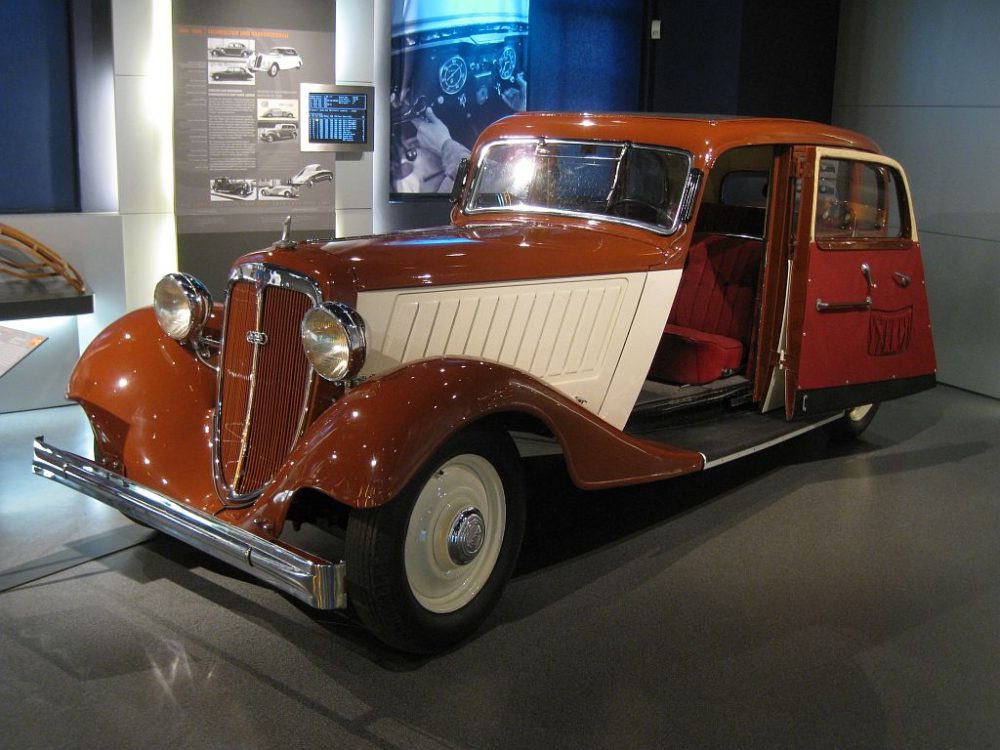The year 1935 marked a pivotal moment in automotive history when Audi unveiled a car that would challenge the conventional wisdom of luxury vehicle design. The Audi Front 225 emerged as Europe’s first production car to combine front-wheel drive with a six-cylinder engine — a configuration that would later become a hallmark of modern luxury vehicles.
This pioneering spirit wasn’t just about being first; it represented a fundamental shift in how engineers approached the marriage of power and control in automotive design. The Front 225 stood as a testament to Audi’s commitment to progressive engineering, setting benchmarks that would influence automotive design for decades to come.
Revolutionary Engineering for Its Time
The heart of the Audi Front 225 beat with remarkable innovation. The 2.25-liter engine delivered 49.7 horsepower at 3,300 rpm — modest by today’s standards but revolutionary for its era. The engine’s architecture, with its 71mm bore and 95mm stroke, demonstrated a keen understanding of the balance between power delivery and mechanical efficiency.
Engineers crafted each component with meticulous attention to detail, ensuring that the front-wheel-drive system could effectively handle the six-cylinder power plant. This combination required solving complex engineering challenges that had deterred other manufacturers from attempting such a configuration.
“The Front 225’s drivetrain layout was decades ahead of its time. We still see its influence in modern luxury car design,” notes Marcus Weber, vintage Audi restoration specialist at Classic Auto Bavaria.
The transmission system represented another leap forward, integrating seamlessly with the front-wheel-drive architecture. This integration required innovative solutions to manage weight distribution and handling characteristics — challenges that would become standard considerations in modern automotive design.
Fact!
The Audi Front 225's engine displacement of 2,257cc was achieved through precise engineering of cylinder dimensions, resulting in an optimal balance between power output and mechanical efficiency — a remarkable achievement for 1930s technology.
Design Evolution and Body Variants
The collaboration between Audi and the Horch body bureau produced a range of body styles that married engineering excellence with aesthetic sophistication. The steel frame construction, weighing approximately 1,330 kg, provided a robust foundation for multiple body configurations.
Each variant — from the stately limousine to the elegant cabriolet — showcased unique design elements while maintaining the model’s distinctive character. The most exclusive of all was the Special Roadster, of which only two examples were ever produced.
- elegant proportions reflecting the era’s design philosophy;
- aerodynamic considerations ahead of their time;
- innovative use of steel frame technology;
- integration of luxury features with sporting pretensions;
- attention to detail in both mechanical and aesthetic elements.
The body design process involved countless hours of wind tunnel testing — remarkable for the 1930s — resulting in a shape that balanced style with aerodynamic efficiency.
Production History and Legacy
Production of the Audi Front 225 spanned from 1935 to 1938, with the limousine variant specifically manufactured between 1935 and 1937. Each vehicle represented a significant investment in both materials and craftsmanship, reflecting the high standards of pre-war German engineering.
“Examining original production documents reveals the extraordinary attention to quality control. Each Front 225 underwent extensive testing before delivery,” shares Dr. Heinrich Mueller, Automotive Historian at the Technical University of Munich.
Historical Reference!
The Audi Front 225's production run coincided with a period of rapid technological advancement in the German automotive industry, making it a benchmark for engineering excellence in the pre-war era.
Today, surviving examples of the Front 225 serve as rolling museums of automotive innovation. The Audi Museum in Ingolstadt proudly displays one of these preserved specimens, offering visitors a glimpse into a transformative period in automotive history.
Collector’s Perspective
The Audi Front 225 holds a special place in collectors’ hearts, particularly the rare Special Roadster variants. The disappearance of both original Roadsters has only enhanced their mystique, leading to the commissioned recreation by Audi Tradition through the Zinke coachworks.
Modern collectors prize these vehicles not just for their rarity but for their historical significance. The Front 225 represents a crucial link in the evolution of luxury car design, making it a highly sought-after piece for serious automotive collections.
The Road Ahead in the Rearview Mirror
Looking back, the Audi Front 225 emerges as more than just a technological pioneer — it was a bold statement about the future of automotive design. Its innovative spirit continues to resonate through Audi’s current lineup, where front-wheel-drive and advanced engine technology remain core components of the brand’s identity.
The true legacy of the Front 225 lies not just in its technical achievements but in its demonstration that revolutionary engineering could be successfully integrated into a production luxury vehicle. This principle continues to guide automotive innovation today.
Pros & Cons
| Advantages | Disadvantages |
|---|---|
| Pioneering front-wheel-drive six-cylinder configuration | Limited production numbers affecting parts availability |
| Revolutionary engineering for its time period | Higher maintenance complexity compared to contemporary models |
| Multiple body styles offering variety | Weight distribution challenges due to front-heavy design |
| Robust steel frame construction | Limited performance by modern standards |
| Significant historical importance | Scarcity of original documentation |
| Advanced aerodynamic design for the era | High restoration costs due to rarity |
| Quality craftsmanship and materials | Complex drivetrain requiring specialized knowledge |
The Audi Front 225 stands as a testament to automotive innovation, demonstrating that true progress often requires challenging established conventions. While its technical specifications might seem modest by today’s standards, its influence on automotive design and engineering continues to resonate nearly nine decades later. For collectors and enthusiasts, it represents not just a car, but a pivotal moment in automotive history when the future of luxury vehicle design began to take shape.

